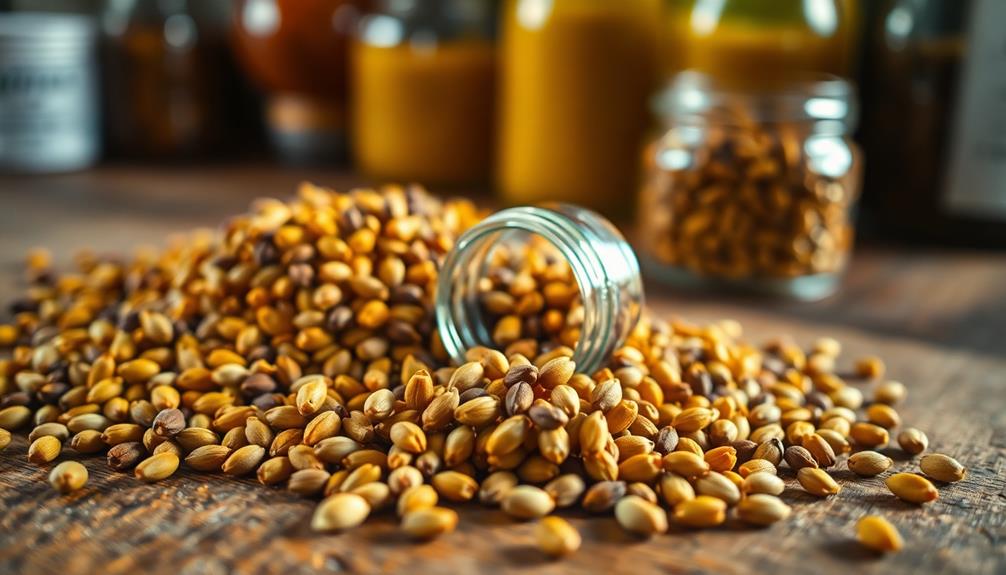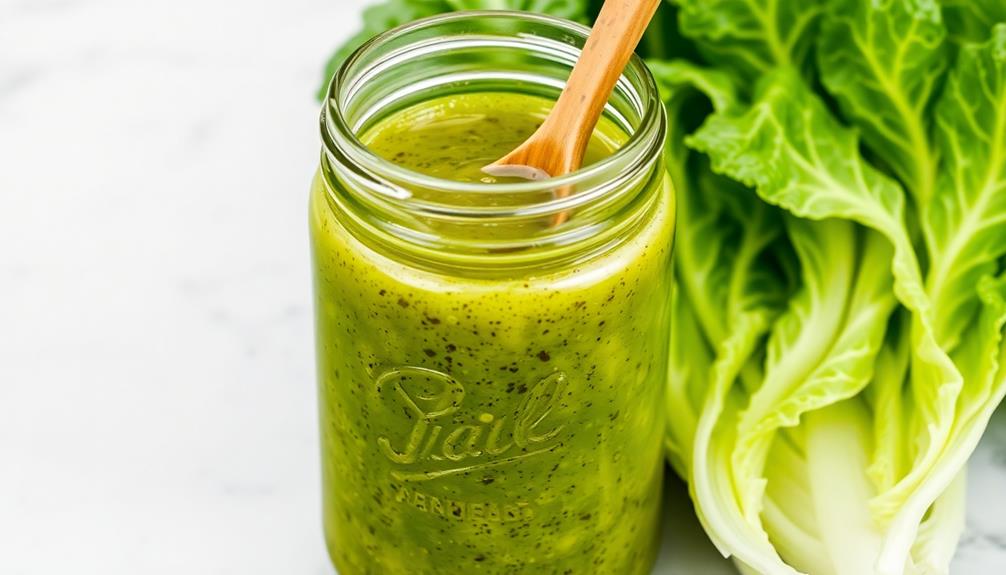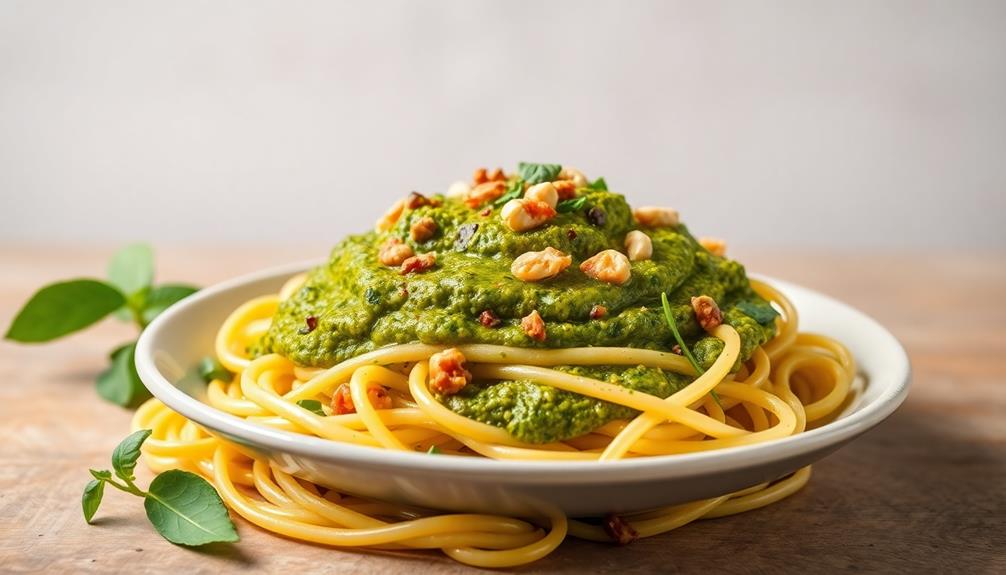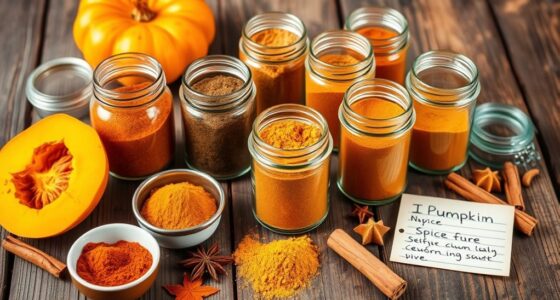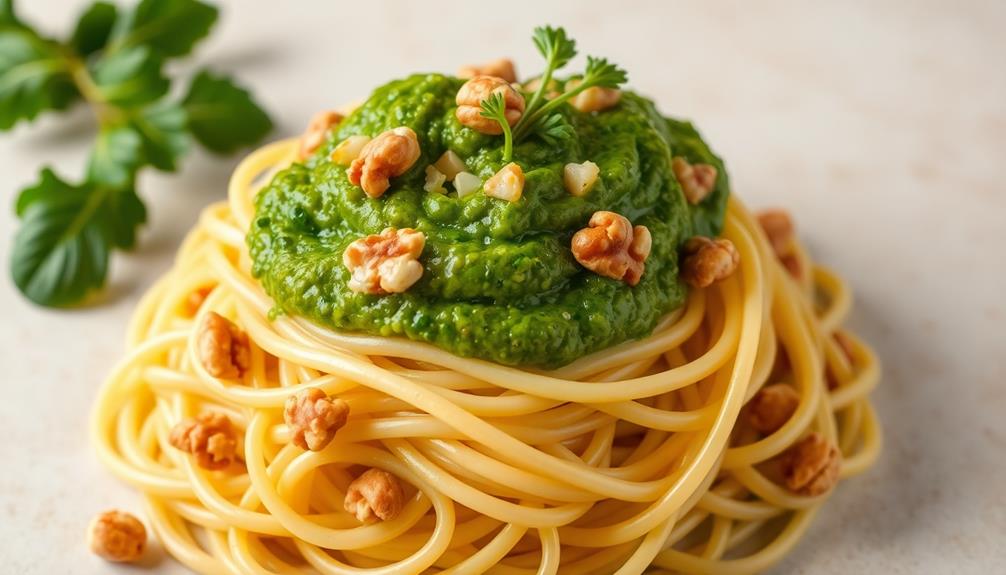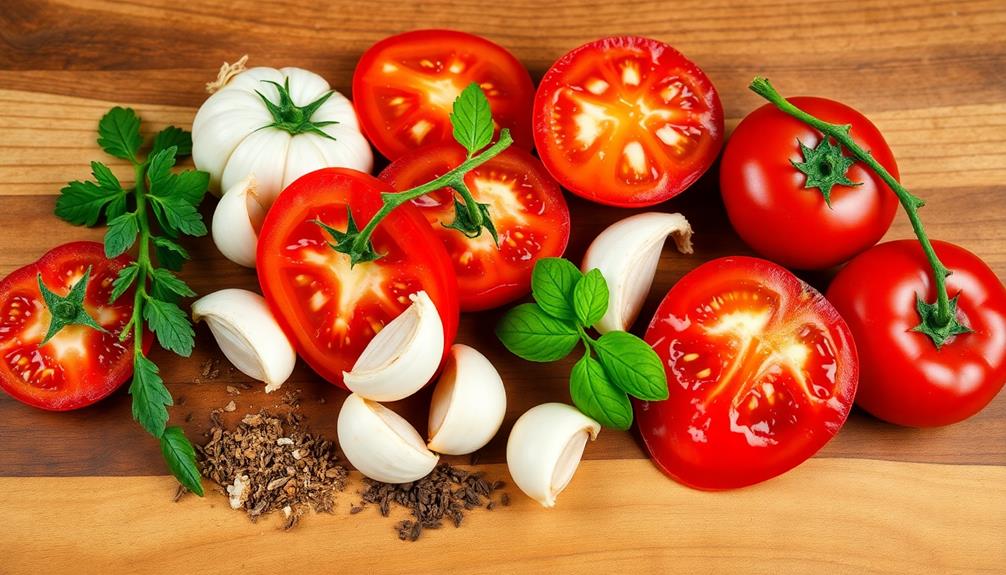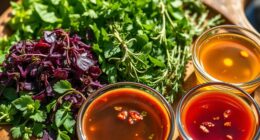Unlock the ancient secrets of crafting mouthwatering mustard right from whole seeds! You'll transform your cooking into a gourmet experience. From the roots of this versatile condiment to the modern art of blending and aging, you'll discover how to create your own signature mustard spreads. Soak, drain, and blend the seeds to achieve a smooth, creamy texture. Then, customize the flavor with spices, herbs, and even a touch of sweetness. Package your masterpiece in decorative jars, and get ready to impress your friends and family. Just wait until you see what else you'll learn about the remarkable world of mustard.
Key Takeaways
- Soaking mustard seeds overnight enhances their nutritional profile and optimizes their texture for blending into a smooth, creamy mustard paste.
- Blending the soaked and rinsed seeds creates a versatile mustard base that can be customized with spices, herbs, and other ingredients to craft unique flavor profiles.
- Proper storage in airtight containers and aging the mustard allows the flavors to develop and mature, resulting in a high-quality, gourmet spread.
- Homemade mustard avoids preservatives and artificial additives, providing a healthier and more cost-effective alternative to store-bought varieties.
- Packaging the homemade mustard in decorative jars and pairing it with complementary foods can elevate casual meals into gourmet experiences.
History
Mustard's history can be traced back thousands of years, with the ancient Egyptians and Chinese among the earliest known producers and consumers of this versatile condiment.
Over time, mustard recipes and techniques spread to other regions, as traders and travelers carried the spice with them. In Europe, mustard became a beloved seasoning, and by the Middle Ages, the French had even developed their own renowned Dijon-style mustard.
As global exploration increased, new mustard varieties emerged, each with its own unique flavor profile.
Today, mustard remains a staple ingredient in cuisines around the world, from the classic American yellow mustard to the bold, pungent varieties found in Indian and Middle Eastern dishes.
Whether you're a mustard enthusiast or just discovering its wonders, this flavorful condiment has a rich and fascinating history that continues to captivate food lovers everywhere. From its origins in ancient civilizations to its diverse range of regional varieties, mustard has stood the test of time as a versatile ingredient. Today, you can find it featured in countless dishes, from gourmet sandwiches to homemade salad dressing recipes that bring a zesty kick to any meal. Its balance of tanginess and spice ensures it remains a beloved staple in kitchens worldwide.
Recipe
Mustard is a versatile condiment that can add a flavorful punch to a variety of dishes. Whether you prefer the smooth and creamy texture of Dijon or the bold, grainy bite of whole-grain mustard, crafting your own homemade version can be a rewarding and customizable experience.
By starting with high-quality ingredients and following a simple recipe, you can create a mustard that perfectly suits your taste preferences. This recipe will guide you through the process of making your own homemade mustard. The result is a condiment that can be used in marinades, dressings, or simply spread on your favorite sandwiches or crackers.
Ingredients:
- 1/2 cup yellow mustard seeds
- 1/4 cup brown mustard seeds
- 1/2 cup white wine vinegar
- 1/4 cup water
- 1 teaspoon salt
- 1 tablespoon honey (optional)
Instructions:
In a small saucepan, combine the yellow and brown mustard seeds with the white wine vinegar and water. Bring the mixture to a simmer over medium heat, then reduce the heat to low and let it gently simmer for 20-25 minutes, stirring occasionally, until the seeds have softened and the liquid has reduced by about half.
Transfer the mixture to a food processor or blender and add the salt. Pulse or blend until the desired consistency is achieved, ranging from a coarse, grainy texture to a smooth, creamy mustard. If using honey, add it to the processor and blend until well incorporated.
Tips:
- For a milder mustard, let the seeds soak in the vinegar and water for 30 minutes to an hour before simmering.
- Adjust the amount of vinegar or water to achieve your preferred consistency.
- Experiment with different types of vinegar, such as apple cider or red wine vinegar, to create unique flavor profiles.
- Store the homemade mustard in an airtight container in the refrigerator for up to 2 weeks.
Cooking Steps
First, you'll soak the mustard seeds in water overnight to soften them up.
Drain and rinse the soaked seeds, then blend them into a smooth paste.
Finally, add in your favorite spices and seasonings to customize the flavor.
Time to get creative and make your very own homemade mustard!
Step 1. Soak Seeds in Water Overnight
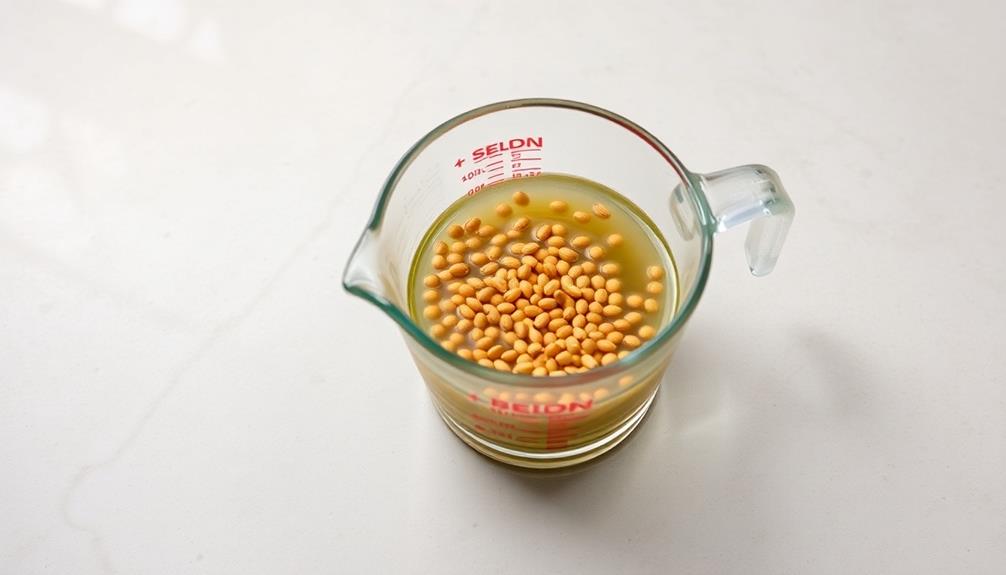
Soaking the mustard seeds overnight is a crucial step in the mustard-making process. By letting the seeds soak, you're softening them up and preparing them for the next steps. It's like giving them a cozy little spa treatment before they get blended and transformed into a delicious spread.
Additionally, soaking the seeds can enhance their nutritional profile, similar to how chia seeds support digestive health by absorbing water and promoting bowel regularity.
Once you've gathered your mustard seeds, simply place them in a bowl and cover them with water. Then, let them sit overnight, or for at least 8 hours. This allows the seeds to absorb the water, which will make them easier to grind and blend later on.
Don't worry if the water looks a bit cloudy – that's just the seeds releasing their natural oils and flavors. In the morning, you'll have plump, hydrated seeds, ready to become the star of your homemade mustard.
Just drain them, and you're one step closer to creating your own unique, tangy condiment.
Step 2. Drain and Rinse Soaked Seeds
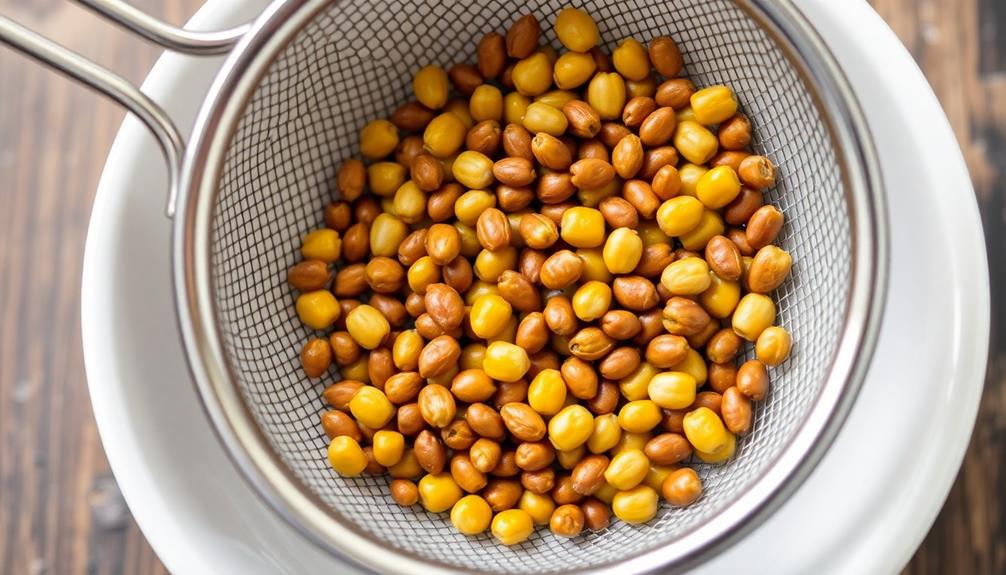
Draining and rinsing the soaked seeds is the next vital step in the mustard-making process. Using a fine-mesh strainer, carefully pour the soaked seeds into the sink, allowing the water to drain out.
Rinse the seeds under cool, running water, gently stirring them with your fingers to remove any remaining dirt or debris. This step helps to prepare the seeds for the next phase of the mustard-making journey.
Once the seeds are rinsed, give the strainer a few shakes to help remove excess water. Don't worry if a few drops remain – the seeds will continue to dry out as you move forward.
With the seeds now clean and ready, you can move on to the exciting task of grinding them into a smooth, flavorful mustard paste. Get ready to unleash the bold, tantalizing aroma that will fill your kitchen!
Step 3. Blend Soaked Seeds Into Smooth Paste
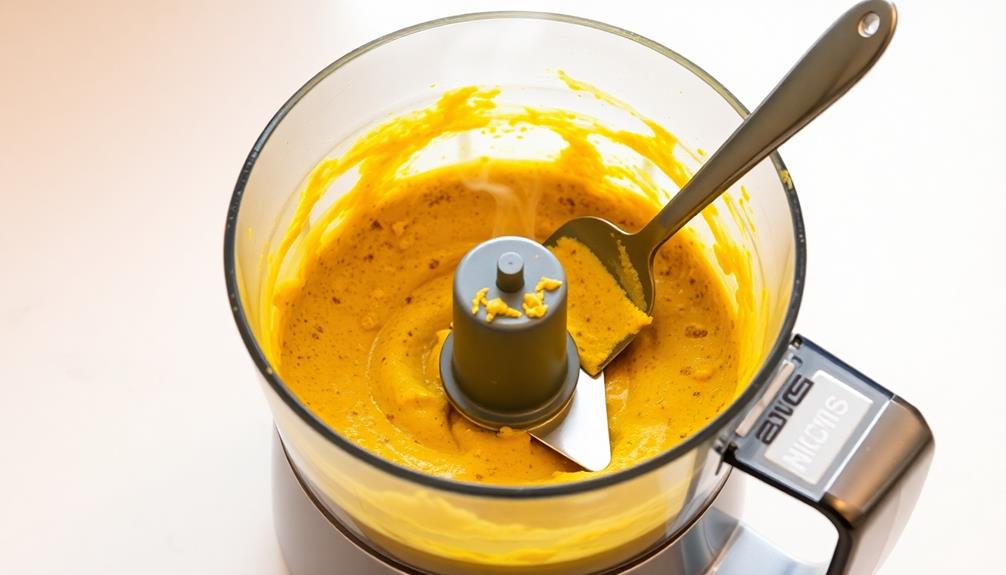
With the soaked and rinsed seeds ready, you'll now need to blend them into a smooth, spreadable mustard paste.
Grab your food processor or high-powered blender and add the drained seeds. Secure the lid and turn the machine on, starting at a low speed. As the seeds begin to break down, gradually increase the speed until you achieve a creamy, lump-free consistency. This may take a minute or two of blending, so be patient and let the machine do its work.
Once the mustard paste looks perfectly smooth, you can transfer it to a bowl or jar for the next step.
Taste the paste and adjust the seasoning if needed, adding a pinch of salt or a touch more vinegar to achieve your desired flavor profile. The smooth, silky texture of the blended mustard is the foundation for all kinds of gourmet spreads and condiments.
Get ready to unlock a world of homemade mustard possibilities!
Step 4. Add Spices and Seasonings
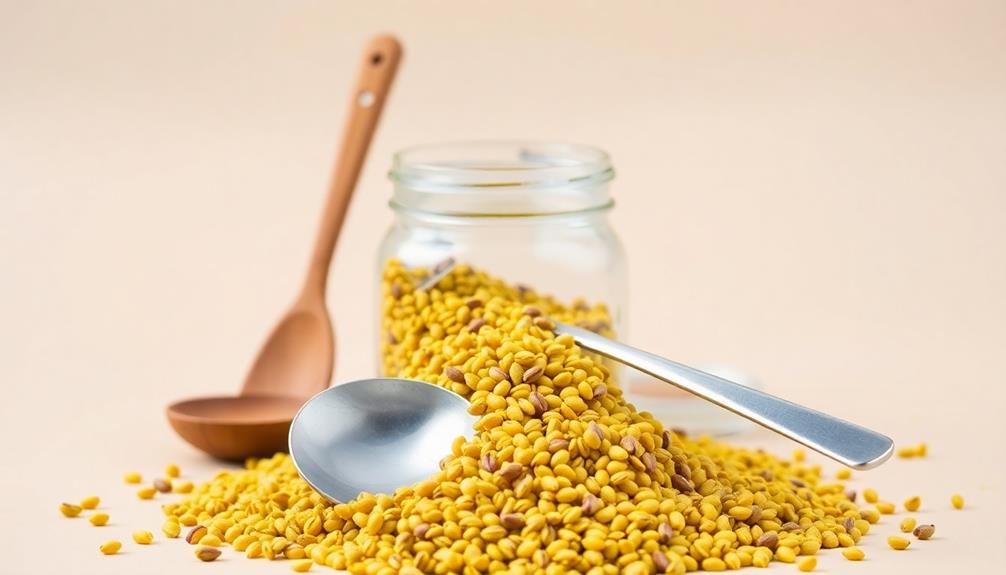
Now that you have a silky smooth mustard paste, it's time to customize the flavor. This is where the real magic happens! You can add a variety of spices and seasonings to create your own unique mustard blend.
Start by mixing in a pinch of salt and a teaspoon of sugar. This will help balance the intensity of the mustard.
Next, consider adding a dash of paprika or cayenne pepper for a subtle heat. Turmeric will give your mustard a vibrant yellow hue, while ground cumin lends an earthy, aromatic note.
Don't be afraid to experiment! Try stirring in a splash of vinegar, a sprinkle of herbs, or even a bit of honey.
The possibilities are endless. Just keep tasting and adjusting the flavors until it's perfect for your palate. The joy is in discovering your new favorite mustard creation. Have fun with it!
Step 5. Transfer to Storage Containers

Convenience beckons as you carefully transfer the customized mustard into your chosen storage containers.
Whether you opt for glass jars, airtight tins, or even repurposed bottles, the possibilities are endless. Savor the moment as you scoop or pour the vibrant, aromatic mixture, taking care not to spill a drop. The satisfying texture and bold flavors are a testament to your hard work and dedication.
As you secure the lids, visualize the delightful ways you'll use this homemade mustard – from adding a zesty kick to sandwiches to elevating your favorite marinades and dressings. These containers will preserve the mustard's freshness, ensuring you can enjoy your creation for weeks to come.
With each storage step, you grow more excited to share your culinary masterpiece with family and friends, who are sure to be impressed by your mustard-making prowess. Bask in the pride of transforming humble seeds into a gourmet spread worthy of any table.
Final Thoughts
Crafting mustard at home can be a rewarding and versatile endeavor. You've learned all the steps – from selecting quality ingredients to blending and aging the perfect spread.
Whether you prefer bold and spicy or mild and creamy, the possibilities are endless. Get creative and experiment with different flavor profiles, like adding herbs, honey, or even a touch of heat.
The beauty of homemade mustard is that you control the ingredients. Avoid preservatives and artificial additives found in store-bought versions.
Plus, you'll save money by making it yourself. Impress your friends and family with your gourmet mustard creations. Package them in cute jars and give as thoughtful gifts.
Or enjoy the fruits of your labor by pairing the mustard with your favorite cheese, meats, or pretzels.
Frequently Asked Questions
How Long Does Homemade Mustard Last?
Homemade mustard can last for several months when stored properly. It'll keep for around 2-3 months in the fridge, though the flavor may diminish over time. Be sure to store it in an airtight container to maximize its shelf life.
Can I Substitute Different Types of Mustard Seeds?
You can absolutely substitute different types of mustard seeds when making homemade mustard. Each variety will offer unique flavors, from the pungent and bold to the mild and sweet. Experiment to find your perfect blend.
What Are the Health Benefits of Mustard?
Mustard seeds are packed with health benefits. They're rich in antioxidants, which can reduce inflammation and improve heart health. Plus, they contain compounds that may help boost your metabolism and digestive function. Give mustard a try for a nutritious flavor boost!
How Do I Adjust the Spice Level of My Mustard?
To adjust the spice level of your mustard, simply add more or less ground mustard seeds to the mixture. The more seeds you use, the hotter your mustard will be. Start with small adjustments to find your perfect level of heat.
Can I Use Mustard in Other Dishes Besides Sandwiches?
Yes, you can use mustard in a variety of dishes besides sandwiches. It's a versatile condiment that can add flavor to sauces, marinades, dips, and even baked goods. Experiment with different mustard varieties to find what works best for your recipes.
